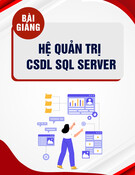
HUFLIT Journal of Science
STREAM ALGEBRA FOR BIG DATA ANALYSIS
Tran Van Lang
HCMC University of Foreign Languages - Information Technology
langtv@huflit .edu.vn
ABSTRACT — This article presents an overview of Stream Algebra, a research field that has emerged after the birth of
Relational Algebra used in Database Management Systems (DBMS). When Stream Data appeared and needed to be processed
in real-time, the role of Stream Algebra became evident. Since the rise of Big Data, this field has received attention in recent
years, the role of Stream Algebra has been further demonstrated. In addition, the article discusses the analysis of big data
based on the approach of Stream Algebra, thereby contributing to determining the research direction in the era of Data
Science for young researchers, graduate students who want to find a challenging research direction. Special focus on analysis
to present some open issues in research on application of Stream Algebra. The article also presents some Frameworks
utilizing Stream Algebra to help stream data management effectively for quick use in research and implementation.
Keywords — Big Data, Data Science, Relational Algebra, DBMS.
I. INTRODUCE
Stream Algebra is a field of study in mathematics and computer science that deals with the modeling and
processing of streams of data [1]; especially in Big Data analytics, where data is processed and analyzed in real
or near real time. A data stream can be understood as a sequence of elements (data, events, signals) generated
over time, usually in temporal and spatial order. Stream Algebra is fundamentally different from traditional
Relational Algebra, which is the foundation of conventional Database Management Systems (DBMS). Stream
Algebra provides a set of operations and rules for processing, transforming, and analyzing data streams.
Operations in Stream Algebra are typically designed to:
Filtering: Filter out elements that meet a specific condition.
Transformation: Converting data from one form to another.
Aggregation: Summarize or calculate a value that represents all or part of a stream, such as an average,
sum, or maximum value.
Join/Merging: Combine multiple data streams together.
Windowing: Divide the data stream into small blocks or windows based on time or number of elements.
Stream Algebra has a deep connection with Mathematics and Formal Language Theory; since data streams are
not just discrete entities but also structured and sequential, it involves mathematical concepts of sequences,
mappings, and formal languages. Specifically:
A data stream can be viewed as a function that maps from a set of indices (usually times) to a set of
values. For example, a temperature stream maps time t to the corresponding temperature.
A data stream can be represented as an infinite or finite sequence of elements .
Stream operations (like filtering, pooling) correspond to sequence operations, like Fourier Transform or
Convolution.
When the data stream represents continuous signals, it belongs to the continuous function space. For
example, an audio signal stream is a continuous function in the time domain.
Algebra structures such as monoids, groups, and rings to describe operations. For example,
concatenation of two streams can be viewed as an operation on a monoid.
A stream can be viewed as a sequence of characters or words in a formal language. For example, a
stream of keyboard events can be represented in a formal language where each event is a character.
Operations on streams, such as filtering or combining, can be expressed using regular expressions. For
example, a stream of events can be described using a regular expression to recognize specific patterns.
Data streams can be modeled by Finite State Machines (FSM), each state corresponding to an element in
the stream. For example, applications that process real-time event streams, such as network protocol
analysis.
When the data stream is more complex and needs a hierarchical structure, context-free grammars can be
used to model the context-free grammars. For example, a source code stream read from a compiler can
be parsed based on a context-free grammar.
REVIEW ARTICLE

84 STREAM ALGEBRA IN BIG DATA ANALYSIS
Stream Algebra can be said to be an application at the intersection of mathematics and formal language theory,
combining mathematical concepts (sequences, mappings, integrals, abstract algebra) with discrete models from
formal language theory. In practice, this intersection appears in:
Signal Processing: Combining continuous space (topology) and discrete structure.
Natural Language Processing ( NLP ): Analysis of text streams or linguistic data.
Software Engineering: Modeling event streams in software systems.
A recent study proposed an algebraic framework to enhance performance in processing computer vision data
stream ([2]). This work studies the construction of computer vision systems using data stream concepts to
process visual data streams. One challenge in building computer vision systems is that algorithms have different
accuracy and speed depending on the content, type of data as well as the speed of incoming data. From there,
how to tune these algorithms in large-scale systems for optimization. This work presents methods and
algorithms to overcome these challenges and improve performance in building and optimizing large-scale
computer vision systems. The approach is to describe an algebraic framework to mathematically describe
computer vision pipelines when processing image and video streams. Thereby providing a formal and abstract
method for optimizing computer vision pipelines.
In recent times, Stream Algebra has been put into practice to develop useful frameworks. For example, the
article [3]on Microsoft Learn introduces windowing functions in Azure Stream Analytics, a real-time data
analytics service from Microsoft that is used when processing data streams. In time-series data processing
scenarios, performing operations on data in time-series windows is a common pattern. Stream Analytics
supports windowing functions out of the box, allowing developers to create complex stream processing jobs
with ease. There are five types of time-series windows to choose from:
Tumbling Window: Divides the data stream into non-overlapping and non-duplicated time segments.
Hopping Window: Similar to tumbling window but can overlap, allowing an event to belong to multiple
windows.
Sliding Window: Unlike tumbling and hopping, sliding windows only output results when the contents of
the window change, that is, when an event enters or exits the window.
Session Window: Groups events that occur close together in time, filtering out inactive periods.
Snapshot Window: A snapshot window that groups events with the same timestamp.
These window functions are applied within the GROUP BY clause of a regular query in Stream Analytics jobs. All
window operations output results at the end of the window. When starting a job in Stream Analytics, it is
necessary to specify the start time of the job output, then the system automatically takes previous events in the
input streams to output the first window at the specified time.
The article [4]focuses on techniques for displaying and analyzing results from windowing operations in two
major stream processing frameworks, Kafka Streams and Flink SQL. It provides some illustrative examples and
detailed explanations of how to implement these techniques in both Kafka Streams and Flink SQL, so that we can
better visualize how to display and analyze results from windowing operations in event stream processing.
Article [5]on Timeplus analyzes the difference between Complex Event Processing (CEP) and Event Stream
Processing (ESP), two important methods in real-time data processing. ESP focuses on processing and analyzing
events as they occur, typically in chronological order. The main goal is to detect patterns or trends in continuous
data streams, allowing for rapid response to important events. ESPs are often used in applications that require
immediate response, such as system monitoring or financial trading. CEP goes further by combining and
analyzing multiple events from different sources to identify complex patterns or causal relationships. It does not
just look at single events but also looks for meaningful combinations of events, helping to detect potential
business opportunities or threats. CEPs are often applied in areas such as business operations monitoring or
sensor network management. The article also details that ESP processes single events or sequential event
chains, while CEP focuses on detecting complex patterns by combining multiple events from different sources.
In application, ESP is suitable for situations that require quick response to single events, while CEP is used to
detect complex event patterns and causal relationships between them. Through the article, it helps
organizations choose the right method for their real-time data processing needs, ensuring timely and effective
response to important events.
Many frameworks implement Stream Algebra; however, many challenges remain in applying it to big data
processing.
A brief introduction to Stream Algebra and recent research is presented above. The remainder of the paper
includes a detailed introduction to Stream Algebra in Section II; Section III presents the application of Stream

Tran Van Lang 85
Algebra in big data analysis. Section IV addresses some of the challenges that remain in exploiting Stream
Algebra as the world moves towards using data to create better human-supporting applications; some
discussions and conclusions are presented at the end of the paper.
II. STREAM ALGEBRA AND SOME RELATED ALGORITHMS
A. BIG DATA
Big Data is a term referring to large, complex, and diverse volumes of data that exceed the processing
capabilities of traditional data management tools and systems. Big Data focuses not only on quantity but also
requires consideration of the velocity, variety, and potential value of data. Big Data is often described through
5V characteristics:
Volume: Very large amounts of data, measured in terabytes, petabytes, or exabytes. Examples: data
from social media, IoT sensors, online transactions.
Velocity: Data is generated and processed rapidly in real or near real time. Examples: financial
transactions, fraud detection systems.
Variety: Data comes in many different formats, from structured data like database tables, to semi-
structured data like XML, and unstructured data like text, images, and videos.
Veracity: Data can be inconsistent, inaccurate, or contain noise, requiring processing methods to ensure
quality and accuracy.
Value: The potential value of big data depends on its ability to extract useful information for Decision-
making.
Big Data is streaming data that is generated continuously, often at high speed and in large volumes (e.g. IoT
sensors, financial transactions, system logs), and needs to be processed immediately to extract information value.
Big Data comes from various sources in modern life such as:
Social Media: Data from Facebook, Twitter, YouTube, and other social media platforms.
IoT devices: Factory measurement sensors, self-driving cars, smart devices.
Trading system: Transaction logs from banks, e-commerce, stock markets.
Scientific systems: Data from scientific, astronomical, medical, and genetic studies.
Big data is the foundation for many advances in various fields:
Business Analytics: Provides information to optimize business processes and increase profits.
Artificial Intelligence: Provides large amounts of data to train machine learning and AI models.
Healthcare: Supports patient data analysis to improve healthcare quality.
Security: Monitor networks, detect and prevent cyber attacks or illegal activities.
While big data offers huge potential, it also comes with many challenges:
Storage: The huge volume of data requires distributed storage systems, such as Hadoop Distributed File
System (HDFS).
Processing: Optimization tools and methods like MapReduce, Apache Spark are needed to process data
efficiently.
Quality assurance: Data often contains a lot of noise or errors, requiring cleaning and preprocessing.
Security: Ensure data is not misused or stolen during storage and processing.
B. STREAM ALGEBRA
Stream Algebra is a set of mathematical rules and operations designed to manipulate and transform stream
data. The main components of Stream Algebra include:
A set of records created over time.
Time windows (time windows/windowing): Divide stream data into small segments for processing.
Stream operations: Includes operations such as mapping, filtering, joining, grouping, and aggregation. For
example, there are operations: Filter to get records with values greater than a threshold; Join to combine two
data streams based on a key; Aggregate to calculate the average or sum over a time window.
Stream Algebra and Relational Algebra are both mathematical systems for modeling and manipulating data, but
serve different purposes and have fundamental differences in how they work, the data they process, and the
operations involved. In general, the comparison between Stream Algebra and Relational Algebra is as shown in
Table 1.

86 STREAM ALGEBRA IN BIG DATA ANALYSIS
Table 1. Comparison of Stream and Relational Algebra
Criteria
Stream Algebra
Relational Algebra
Data type
Continuous, chronologically ordered data
Static data, stored as tables
Processing
mechanism
Real-time or near-real-time processing
Batch processing
Time window
Support, time-based data segmentation
Not applicable
Basic math
map, filter, join, aggregation, sliding
windows
select, project, join, union, intersection
Performance
Optimized for data processing speed
Optimized for data storage and
querying
Application
Real-time analytics, IoT, anomaly detection
Static data storage and analysis
The detailed differences are shown through the following comparisons.
1. DATA NATURE
Stream Algebra:
Data is represented as a continuous stream (streams), which can be infinite, with elements arriving over time.
Focuses on data that is real-time, ordered, and often related to a temporal context.
For example: Data from sensors, events in IoT systems, or financial transactions.
Relational Algebra :
Data is organized into relations (tables), which are finite sets of records. Focuses on static data, independent of
order, with no concept of time.
For example: Database like customer table or transaction table.
2. PROCESSING MODEL
Stream Algebra:
Operations that process each element in a stream as it appears, often based on temporal or sequential context.
Real-time or near-real-time processing requires high performance and low latency. Windowing is an important
concept for grouping and processing continuous data.
Relational Algebra:
Operations are applied to the entire data set at once. Processing is done offline or on static data stored in a
database. There is no concept of time or data windows.
3. MATH
Stream Algebra:
The common operations as mentioned above, are
Filter: Filter elements according to conditions.
Transform: Convert data into another form.
Aggregate: Calculates the average, sum, or count on a data window.
Windowing: Group data by time windows.
Stream Join: Combines two or more data streams.
Relational Algebra:
Standard operations:
Selection: Select records according to conditions.
Projection: Select specific properties.
Join: Combines two tables based on a common key.
Union, Intersection , Difference: Set operations on tables .
4. APPLICATION
Stream Algebra:
Real-time data processing in distributed systems, IoT, and Complex Event Processing – CEP; such as Apache
Flink, Kafka Streams, Flink SQL, Spark Streaming, Azure Stream Analytics, …
Relational Algebra:
Query static data in relational databases; such as MySQL, PostgreSQL, Oracle, …
5. MATHEMATICAL PROPERTIES
Stream Algebra:

Tran Van Lang 87
Depends on timeline and concept of order. Data can change continuously, so operations need to ensure
continuous calculation and update of results.
Relational Algebra:
Depends on sets and concepts in set algebra. There is no continuous change or update when performing
operations.
C. SOME ALGORITHM ON STREAM ALGEBRA
Some related algorithms about operations on Stream Algebra:
Filtering algorithm: Used to remove unnecessary data, for example filtering events whose values exceed
a certain threshold.
Aggregate algorithms: Used to calculate statistics on data, such as sum, average, count.
Join Algorithm: Used to combine data from different streams based on one or more keys.
Windowing algorithm: Used to divide data into time windows and perform calculations on each window.
Complex event processing algorithm: Used to detect complex events from data streams.
Some algorithms using the operations of Stream Algebra:
Ford-Fulkerson Algorithm: Classic algorithm for solving maximum stream problem in graphs.
Edmonds-Karp algorithm: A variant of the Ford-Fulkerson algorithm, more commonly used because of
its better time complexity.
Dinitz Algorithm: Another algorithm for solving the maximum stream problem, which has better time
complexity than both Ford-Fulkerson and Edmonds-Karp.
Tree-based algorithms: Some algorithms use tree structures to represent and process stream data.
Distributed Algorithms: Algorithms designed to run on parallel/distributed systems.
III. APPLICATIONS OF STREAM ALGEBRA IN BIG DATA ANALYTICS
In the context of big data, Stream Algebra stands out for its role in real-time processing. Instead of waiting to
analyze data in batches, Stream Algebra allows for rapid analysis as data is generated. This is important in
applications such as:
Detect financial transaction fraud instantly.
Analyze user behavior on online platforms to optimize experience.
Predict and respond to emergency events, such as natural disaster forecasting from sensor data.
IoT System.
Monitor sensor data in real time to predict equipment failures.
Supply Chain Management.
Track data streams from RFID devices for inventory management.
…
The paper [6]published in the journal Data in July 2024 focuses on improving the performance of Complex
Event Processing systems through database indexing strategies. The main content of the paper is to introduce
CEP, which is an important processing for real-time analysis of continuous event streams in many fields such as
finance, logistics, and security. With the increase in the volume and complexity of event data, optimizing the
performance of CEP systems becomes a key challenge. The paper also proposes a new indexing technique called
Hierarchical Temporal Indexing (HTI), which is specifically designed to efficiently process complex event
queries. HTI takes advantage of the temporal nature of event data and applies a multi-level indexing method to
optimize query execution. By combining temporal indexing with spatial and attribute indexing, HTI aims to
speed up the retrieval and processing of related events, thereby improving the overall query performance. This
study also evaluates the effectiveness of HTI by implementing complex event queries on multiple CEP systems
with different indexing strategies. The performance analysis includes measuring query execution time, resource
utilization (CPU, memory, etc.), and analyzing the execution plans and query optimization techniques applied by
each system. The research results show a significant improvement in execution time compared to traditional
indexing strategies, especially in queries that require processing complex event data. In terms of resource
utilization, HTI reduces CPU and memory load, making the CEP system more efficient in resource-constrained
environments. Applying HTI results in more efficient query execution plans, reduced I/O operations, and
increased data retrieval speed indicating that the query is also optimized.
In terms of technology, Apache Flink and Apache Kafka Streams are two powerful frameworks in the field of
stream data processing [7]. Both are being actively developed with many new research and improvements.
Some highlights of each framework are as follows. Apache Flink has low latency and the ability to process both
streams and batch data through improvements in memory management, task scheduling, and optimization of


























